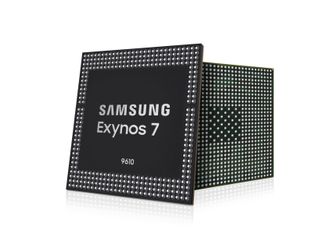Samsung's Exynos 9610 chipset brings AI and 480fps video recording to the mid-range segment

Samsung has announced the latest chipset in the mid-range Exynos 7 Series, the Exynos 9610. Naming irregularities aside, there's a lot to like in the Exynos 9610. The chipset is built on the 10nm node — much like the Exynos 9810 and the Snapdragon 845 — and comes with a host of new features that include AI-based image processing, 480fps slow-motion video recording, and increased performance.
The marquee feature is the upgraded multimedia capabilities, with the Exynos 9610 featuring a neural network engine for "enhanced face detection, as well as single camera out-focusing and augmented low-light images." Samsung says the face detection algorithm detects faces that are partially covered (with a hat or a sizeable beard, for instance), and that its smart depth sensing algorithm allows for portrait mode with a single camera, similar to what Google offers on the Pixel 2.
The image signal processor in the Exynos 9610 will also allow users to shoot 480fps slow-motion videos in Full HD, and 4K video at 120fps. The Galaxy S9+ also shoots 4K at 120fps, and it comes with a super slo-mo feature as well that enables recording at 960fps. With the Exynos 9610, Samsung is looking to bring a similar set of features to the mid-range segment.
The predecessor to the Exynos 9610 — the Exynos 7885 — featured a six-core design with two high-performance Cortex A73 cores, but Samsung is switching to an octa-core design this time around, offering four Cortex A73 cores clocked up to 2.3GHz coupled with four Cortex A53 cores at 1.6GHz. On the GPU side of things, the Exynos 9610 is sporting ARM's Mali-G72 — the same as the Exynos 9810 in the Galaxy S9.
The chipset also comes with a low-power core based on the Cortex-M4F that facilitates gesture recognition and context awareness. Finally, the Exynos 9610 features a Category 13 LTE modem with 3CA (carrier aggregation) that offers maximum download speeds of 600Mbps and uploads up to 150Mbps. There's also 802.11ac 2x2 MIMO Wi-Fi, Bluetooth 5.0, and an FM radio transceiver.
Samsung says that the Exynos 9610 will go into mass production in the latter half of the year. The chipset is targeted at the mid-range segment, and is likely to power the successor to the Galaxy A8.
Be an expert in 5 minutes
Get the latest news from Android Central, your trusted companion in the world of Android

Harish Jonnalagadda is a Senior Editor overseeing Asia at Android Central. He leads the site's coverage of Chinese phone brands, contributing to reviews, features, and buying guides. He also writes about storage servers, audio products, and the semiconductor industry. Contact him on Twitter at @chunkynerd.
